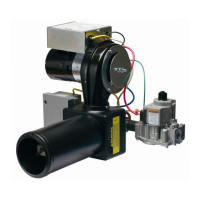8
INSPECTION OF HEATING APPLIANCE
Clean the appliance heat exchanger interior, combustion chamber and flue connections. Remove all adhering tars, scale, dirt, and
soot. Inspect the heat exchanger for obvious and potential flue gas leaks. Cement all joints around the appliance base and ac cess
openings to prevent air and/or flue gas leakage into or out of the combustion chamber.
Warm Air Furnaces* - Make certain the electrical characteristics of the fan and limit switch correspond to those required
by this burner and that they are in proper working order.
Hot Water Boilers* - Make certain water temperature and altitude gauges, pressure relief valves are in proper working order.
Steam Boilers* - Make certain the system is pressure tight and that the pressure gage and pop off safety valve are in proper
working order. Verify existing water sight glass permits clear observation of boiler water level.
*Where applicable, existing temperature of pressure limit switch or low water cut-off switch operation and electrical characteristics
shall be checked to determine their compatibility to the gas control circuitry of this burner.
NOTE: For oil fired conversions consult boiler or furnace manufacturer. Appliance must maintain negative draft over fire.
FLUE PIPE, DRAFT HOOD, AND BAROMETERIC DAMPER
A CSA type draft hood or its equivalent shall be placed in and made part of the flue pipe from the appliance. A barometric damper may
be used in place of the draft hood where permitted by local building codes. If an oil barometric damper has been previously i nstalled
this may be used if it is in good condition and any and all weights and/or stops are removed. The flapper on a gas barometric damper
must be free swinging in both directions. Check with local building codes and building inspectors. At no time should the draft hood be
located at a point lower than the highest flue passage in the appliance. The draft hood should be installed in the position for which it
was designed and in no case installed in a false ceiling, separate room from the heating appliance, or in any other manner th at will
permit a difference in pressure between the draft hood relief opening and the combustion air supply. On sealed type appliances where
all combustion air is taken from the outside, a cap should be installed on end of flue pipe to prevent back drafts. In such c ases no draft
hood or diverter should be installed inside (See Figure 3).

